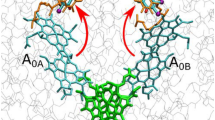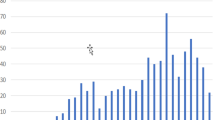Abstract
The photochemical reactivity of β-lapachone (1), nor-β-lapachone (2) and β-lapachone 3-sulfonic acid (3) has been examined by laser flash photolysis. Excitation (λ = 266 nm) of degassed solutions of 1–3, in acetonitrile or dichloromethane, resulted in the formation of detectable transients with absorption maxima at 300, 380 and 650 nm. These transients, with lifetimes of 5.0 μs, were quenched by β-carotene at a diffusion-controlled rate constant and assigned to the triplet excited states of 1–3. Addition of hydrogen donors, such as 2-propanol, 1,4-cyclohexadiene, 4-methoxyphenol or indole led to the formation of new transients, which were assigned to the corresponding ketyl radicals obtained from the hydrogen abstraction reaction by the triplets 1–3. In the presence of triethylamine it was observed the formation of the long-lived anion radical derived from 1–3, which shows absorption maxima at 300 and 380 nm. The low values observed for the hydrogen abstraction rate constants for the β-lapachones 1–3 using 2-propanol and 1,4-cyclohexadiene as quenchers led us to conclude that their triplet excited states show ππ* character.
Similar content being viewed by others
References
S. Subramanian, M. M. C. Ferreira, M. Trsic, A structure-activity relationship of lapachol and some derivatives of 1,4-naphthoquinones against carcinosarcoma Walker 256, Struct. Chem., 1998, 9, 47.
C. N. Pinto, A. P. Dantas, K. C. G. de Moura, F. S. Emery, P. F. Polequevitch, M. D. Pinto, S. L. de Castro, A. V. Pinto, Chemical reactivity studies with naphthoquinones from Tabebuia with antitrypanosomal efficacy, Arzneim-Forsch, 2000, 50, 1120.
A. F. dos Santos, P. A. L. Ferraz, A. V. Pinto, M. C. F. R. Pinto, M. O. F. Goulart, A. E. G. Sant’Ana, Molluscicidal activity of 2-hydroxy-3-alkyl-1,4-naphthoquinones and derivatives, Int. J. Parasitol., 2000, 30, 1199.
A. F. dos Santos, P. A. L. Ferraz, F. C. de Abreu, E. Chiari, M. O. F. Goulart, A. E. G. Sant’Ana, Molluscicidal and trypanocidal activities of lapachol derivatives, Planta Med., 2001, 67, 92.
M. J. Teixeira, Y. M. Almeida, J. R. Viana, J. G. Holanda Filho, T. P. Rodrigues, J. R. C. Jr. Prata, I. C. B. Coelho, V. S. Rao, M. M. L. Pompeu, In vitro and in vivo leishmanicidal activity of 2-hydroxy-3-(3-methyl-2-butenyl)-1,4-naphthoquinone (lapachol), Phytother. Res., 2001, 15, 44.
K. V. Rao, Quinone natural products-streptonigrin (NSC-45383) and lapachol (NSC-11905) structure-activity relationships, Cancer Chemother. Rep., 1974, 4, 11.
S. Gafner, J.-L. Wolfender, M. Nianga, H. Stoeckli-Evans, K. Hostettmann, Antifungal and antibacterial naphthoquinones from Newbouldia laevis roots, Phytochemistry, 1996, 4, 1315.
R. Docampo, J. N. Lopes, F. S. Cruz, W. DeSouza, Trypanosoma cruzi: ultrastructural and metabolic alterations of epimastigotes by β-lapachone, Exp. Parasitol., 1977, 42, 142.
R. Docampo, F. S. Cruz, A. Boveris, R. P. A. Muniz, D. M. S. Esquivel, Lipid peroxidation and generation of free-radicals, superoxide anion, and hydrogen peroxide in β-lapachone-treated Trypanosome Cruzi epimastigotes, Arch. Biochem. Biophys., 1978, 186, 292.
K. C. G. de Moura, F. S. Emerya, C. Neves-Pinto, M. C. F. R. Pinto, A. P. Dantas, K. Salomão, S. L. Castro, A. V. Pinto, Trypanocidal activity of isolated naphthoquinones from Tabebuia and some heterocyclic derivatives: a review from an interdisciplinary study, J. Braz. Chem. Soc., 2001, 12, 325.
A. B. Pardee, Y. Z. Li, C. J. Li, Cancer therapy with β-lapachones, Curr. Cancer Drug Targets, 2002, 2, 227.
F. C. Abreu, D. C. M. Ferreira, J. Wadhawan, C. Amatore, V. F. Ferreira, M. N. Silva, M. C. B. V. Souza, T. S. Gomes, E. A. Ximenes, M. O. F. Goulart, Electrochemistry of β-lapachone and its diazoderivative: relevance to their compared antimicrobial activities, Electrochem. Commun., 2005, 7, 767.
J. S. Driscoll, G. F. Hazard, H. B. Wood, Structure-antitumor activity relationships among quinone derivatives, Cancer Chemother. Rep., 1974, 4, 1.
J. N. Lopes, F. S. Cruz, R. DoCampo, In vitro and in vivo evaluation of the toxicity of 1,4-naphthoquinone and 1,2-naphthoquinone derivatives against Trypanosoma cruzi, Ann. Trop. Med. Parasit., 1978, 72, 523.
C. J. Li, L. J. Zhang, B. J. Dezubw, C. S. Crumpacker, A. B. Pardee, Three inhibitors of type 1 human immunodeficiency virus long terminal repeat-directed gene expression and virus replication, Proc. Natl. Acad. Sci. USA, 1993, 90, 1839.
M. E. Dolan, B. Frydman, C. B. Thompson, A. M. Diamond, B. J. Garbiras, A. R. Safa, W. T. Beck, L. Marton, Effects of 1,2-naphthoquinones on human tumor cell growth and lack of cross-resistance with other anticancer agents, J. Anticancer Drugs, 1998, 9, 437.
C. J. Li, I. Averboukh, A. B. Pardee, β-Lapachone, a novel DNA topoisomerase I inhibitor with a mode of action different from camptothecin, J. Biol. Chem., 1993, 268, 22463.
D. A. Boothman, D. K. Trask, A. B. Pardee, Inhibition of potentially lethal DNA damage repair in human tumor cells by β-lapachone, an activator of topoisomerase I, Cancer Res., 1989, 49, 605.
B. Frydman, L. J. Marton, J. S. Sun, K. Neder, D. T. Witiak, A. A. Liu, H.-M. Wang, Y. Mao, H.-V. Wu, M. M. Sanders, L. F. Liu, Induction of DNA Topoisomerase II-mediated DNA cleavage by β-lapachone and related naphthoquinones, Cancer Res., 1997, 57, 620.
S. M. Planchon, S. Wuerzberger, B. Frydman, D. T. Witiak, P. Hutson, D. R. Church, G. Wilding, D. A. Boothman, β-Lapachone mediated apoptosis in human promyelocytic leukemia (HL-60) and human prostate cancer cells: a p53-independent response, Cancer Res., 1995, 55, 3706.
C. J. Li, C. Wang, A. B. Pardee, Induction of apoptosis by β-lapachone in human prostate cancer cells, Cancer Res., 1995, 55, 3712.
J. J. Pink, S. M. Planchon, C. Tagliarino, M. E. Varnes, D. Siegel, D. A. Boothman, NAD(P)H:Quinone oxidoreductase activity is the principal determinant of β-lapachone cytotoxity, J. Biol. Chem., 2000, 276, 6416.
X. H. Ci, R. S. Silva, J. L. Goodman, D. E. Nicodem, D. G. Whitten, A reversible photoredox reaction-electron-transfer photoreduction of β-lapachone by triethylamine, J. Am. Chem. Soc., 1988, 110, 8548
X. H. Ci, R. S. Silva, D. E. Nicodem, D. G. Whitten, Electron and hydrogen-atom transfer mechanisms for the photo-reduction of ortho-quinones - Visible light induced photoreactions of β-lapachone with amines, alcohols, and amino-alcohols, J. Am. Chem. Soc., 1989, 111, 1337.
E. Paternò, Ricerche sull’acido lapacico, Gazz. Chim. Ital., 1882, 12, 337.
S. C. Hooker, The constitution of lapachic acid (lapachol) and its derivatives, J. Chem. Soc., 1892, 61, 611.
F. W. Ribeiro, M. C. F. R. Pinto, A. V. Pinto, C. G. T. Oliveira, V. F. Ferreira, 13C Nuclear magnetic resonance study of 1,2- and 1,4-naphthoquinones and their derivatives, J. Braz. Chem. Soc., 1990, 1, 55.
S. C. Hooker, Lomatiol Part 11. Its occurrence, constitution, relation to and conversion into lapachol. Also a synthesis of lapachol, J. Am. Chem. Soc., 1936, 58, 1181.
A. V. Pinto, M. C. F. R. Pinto, C. G. T. Oliveira, Synthesis of α- nor-lapachone and β- nor-lapachone in acid medium and reactions with N-bromosuccinimide, Ann. Acad. Brazil. Ciênc., 1982, 54, 107.
L. F. Fieser, Naphthoquinone antimalarials. 16. Water-soluble derivatives of alcoholic and unsaturated compounds, J. Am. Chem. Soc., 1948, 70, 3232.
R. Bensasson, E. J. Land, B. Mavdinas, Triplet-states of Carotenoids from photosynthetic bacteria studied by nanosecond ultraviolet and electron pulse irradiation, Photochem. Photobiol., 1976, 23, 189.
C. V. Kumar, S. Chattopadhay, P. K. Das, Triplet excitation transfer to carotenoids from biradical intermediates in Norrish type-II photoreactions of ortho-alkyl-substituted aromatic carbonyl compounds, J. Am. Chem. Soc., 1983, 105, 5143.
O. Stern, M. Volmer, The fading time of fluorescence, Physik Z., 1919, 20, 183.
M. Barra, E. D. Harder, J. P. Balfe, Influence of solvent polarity on the photoreactivity of 2-4-ring aromatic ortho-quinones, J. Chem. Soc., Perkin Trans. 2, 1999, 1439.
R. S. Silva, D. E. Nicodem, Solvent and temperature effects on the phosphorescence of 9,10-phenanthrenequinone in fluid solution, J. Photochem. Photobiol., A, 2004, 162, 231.
Y. Harada, S. Watanabe, T. Suzuki, T. Ichimura, Photochemical reaction dynamics of 9,10-phenanthrenequinone and 1,2-naphthoquinone with hydrogen donors in solution, J. Photochem. Photobiol., A, 2005, 179, 161.
Y. Pan, Y. Fu, S. Liu, H. Yu, Y. Gao, Q. Guo, S. Yu, Studies on photoinduced H-atom and electron transfer reactions of o-naphthoquinones by laser flash photolysis, J. Phys. Chem. A, 2006, 110, 7316.
N. C. de Lucas, M. M. Elias, C. L. Firme, R. J. Corrêa, S. G. Garden, J. C. Netto-Ferreira and D. E. Nicodem, to be published.
J. C. Scaiano, M. V. Encinas, Reaction of benzophenone triplets with allylic hydrogen - a laser flash photolysis study, J. Am. Chem. Soc., 1981, 103, 6393.
J. C. Scaiano, V. Wintgens, J. C. Netto-Ferreira, Importance of neighbouring group participation in the remarkably rapid photoreduction of 1,1,4,4-tetramethyl-1,4-dihydro-2,3-naphthalendione, Photochem. Photobiol., 1989, 50, 707.
S. V. Jovanovic, D. G. Morris, C. N. Pliva, J. C. Scaiano, Laser flash photolysis of dinaphthylketones, J. Photochem. Photobiol., A, 1997, 107, 153.
D. E. Nicodem, R. S. Silva, D. M. Togashi, M. F. V. Cunha, Solvent effects on the quenching of the equilibrating n,π* and π* triplet states of 9,10-phenanthrenequinone in 2-propanol, J. Photochem. Photobiol., A, 2005, 175, 154.
J. C. Scaiano, Intramolecular Photoreduction of Ketones, J. Photochem., 1973/74, 2, 81.
N. J. Turro, J. C. Dalton, K. Dawes, G. Farrington, R. Hautala, D. Morton, M. Niemczyk, N. Schore, Molecular photochemistry of alkanones in solution-α-cleavage, hydrogen abstraction, cycloaddition, and sensitization reactions, Acc. Chem. Res., 1972, 5, 92.
H. Lutz, E. Breherdt, L. Lindqvist, Effects of solvent and substituents on absorption spectra of triplet acetophenone and acetophenone ketyl radical studied by nanosecond laser photolysis, J. Phys. Chem., 1973, 77, 1758.
N. C. Yang, R. L. Dusenberg, Correlation between photochemical reactivity and nature of excited states of acetophenone and substituted acetophenones, J. Am. Chem. Soc., 1968, 90, 5899.
S. Steenken, P. Neta, One-electron redox potentials of phenols-hydroxyphenols and aminophenols and related compounds ob biological interest, J. Am. Chem. Soc., 1982, 86, 3661.
P. K. Das, M. V. Encinas, J. C. Scaiano, Laser flash photolysis study of the reactions of carbonyl triplets with phenols and photochemistry of p-hydroxypropiophenone, J. Am. Chem. Soc., 1981, 103, 4154.
N. J. Turro, R. Engel, Quenching of biacetyl fluorescence and phosphorescence, J. Am. Chem. Soc., 1969, 91, 7113.
L. Biczók, T. Bérces, H. Linschitz, Quenching processes in hydrogen-bonded pairs: interactions of excited fluorenone with alcohols and phenols, J. Am. Chem. Soc., 1997, 119, 11071.
W. J. Leigh, E. C. Lathioor, M. J. St Pierre, Photoinduced hydrogen abstraction from phenols by aromatic ketones. A new mechanism for hydrogen abstraction by carbonyl n,π* and π* triplets, J. Am. Chem. Soc., 1996, 118, 12339.
M. A. Miranda, A. Lahoz, F. Boscá, M. R. Metni, F. B. Abdelouahab, J. Pérez-Prieto, Regio- and stereo-selectivity in the intramolecular quenching of the excited benzoylthiophene chromophore by triptophan, Chem. Commun., 2000, 2257.
M. A. Miranda, A. Lahoz, R. Matínez-Mañez, F. Boscá, J. V. Castell, J. Pérez-Prieto, Enantioselective discrimination in the intramolecular quenching of an excited aromatic ketone by a ground state phenol, J. Am. Chem. Soc., 1999, 121, 11569.
N. C. de Lucas, R. J. Correa, A. C. C. Albuquerque, C. L. Firme, S. J. Garden, A. R. Bertoti, J. C. Netto-Ferreira, Laser flash photolysis of 1,2-diketopyracene and a theoretical study of the phenolic hydrogen abstraction by the triplet state of cyclic α-diketones, J. Phys. Chem. A, 2007, 111, 1117.
E. C. Lathioor, W. J. Leigh, Bimolecular hydrogen abstraction from phenols by aromatic ketone triplets, Photochem. Photobiol., 2006, 82, 291.
G. Merényi, J. Lind, X. Shen, Electron-transfer from indoles, phenol, and sulfite (SO3−2) to chlorine dioxide (ClO2), J. Phys. Chem., 1988, 92, 134.
R. H. Schuler, P. Neta, H. Zemel, R. W. Fessenden, Conversion of hydroxyphenyl to phenoxyl radicals-radiolytic study of reduction of bromophenols in aqueous solution, J. Am. Chem. Soc., 1976, 98, 3825.
J. Pérez-Prieto, F. Boscá, R. E. Galian, A. Lahoz, L. R. Domingo, M. A. Miranda, Photoreaction between 2-benzoylthiophene and phenol or indole, J. Org. Chem., 2003, 68, 5104.
Author information
Authors and Affiliations
Corresponding author
Rights and permissions
About this article
Cite this article
Netto-Ferreira, J.C., Bernardes, B., Ferreira, A.B.B. et al. Laser flash photolysis study of the triplet reactivity of β-lapachones. Photochem Photobiol Sci 7, 467–473 (2008). https://doi.org/10.1039/b716104b
Received:
Accepted:
Published:
Issue Date:
DOI: https://doi.org/10.1039/b716104b




